REMINISCENCES: A Yellow Mongoose Marvel
The Kgalagadi Transfrontier National Park is a
favoured destination for local and overseas wildlife photographers alike. The
wide riverbeds of the Auob and Nossob, as well as the undulating red dune-fields,
provide clear shots of wildlife unencumbered by thick bush. Sadly, I have not
had enough opportunities to visit this unique gem in the past.
Several years ago, I decided that Jacqui needed
to experience the world of the Kgalagadi. At the time, the only vehicle I could
use for the trip was a reliable but very low Ford Lazer Tonic. I had not
visited the Kgalagadi for several years before this trip. Therefore, I was not
prepared for what lay ahead of us.
At Twee Rivieren, our entry-point into the park,
we were informed that the southernmost half of the road leading to Nossob Camp
was closed to traffic. We first would have to follow the Auob River that winds
its way down from Mata-Mata, then use the Dune Road to cut back onto the Nossob
River Road. This detour would add many hours of travel until we finally reached
our camp.
We had planned our stay for late December. Having
arrived at Twee Rivieren in the middle of the morning, we now trundled off in
fierce heat. When we arrived at the junction of the detour and the actual road
to Nossob, the second disappointment was revealed. The parks board had decided
not to scrape the road along the Nossob River – this was done as part of an ongoing
effort to test which best-practice of road maintenance should be implemented in
the future to preserve the fragile roads and the environment.
This cessation of road maintenance had left a
deeply-rutted track, flanked on each side by a very high shoulder of soft sand.
Often, the track was so deep and the verges on either side so high that all
Jacqui and I could look at from our very low vantage point was the road ahead.
Very often, for a kilometre or more, we could not see the riverbed at all. Worse
still, the Kgalagadi had decided to refresh itself with daily thundershowers. Low-hanging
grey clouds blanketed the sky early in the mornings and late in the afternoons.
There was no chance of capturing exciting images of the Kgalagadi and its many
denizens in spectacular soft light on this trip.
At dusk on our second day at Nossob, a large, handsome
yellow mongoose male ran hither and thither across the open camping ground. This
piqued my interest, and I watched the male mongoose’s actions carefully. After
his last foray to the fire-sides of the various groups of campers – to filch
some boerewors or a carelessly discarded lamb-chop bone – the mongoose shuffled
to a quiet spot far away from all campers and disappeared down a burrow.
Before sunrise the next morning, I scouted out
the location of the mongoose burrow very carefully. The yellow mongoose male
was nowhere to be seen. On our early return from a morning drive, I noticed
that a very sleek female yellow mongoose was sitting just outside of the burrow
entrance. From a low grassy knoll, the male approached the female. Their
friendly greeting-ceremony left no doubt in my mind that these two adult
mongooses were a pair. My suspicions were confirmed when a very small head
popped above the lip of the burrow, to look at the strange animal sitting
close-by, clicking away at a strange machine held tightly in its hands and
balanced on sun-reddened knees. An over-hasty camper approached – the mongoose
family fled down their burrow.
In the evening, I again managed to approach the
female and her two pups slowly and carefully. They entertained me with glimpses
of yellow mongoose family-life. The male did not join in. Sadly, this was in
all likelihood the last glimpse I got of the yellow mongoose family.
At midday of the fourth day, I had all but
given up on the yellow mongooses. They had obviously moved out of their burrow
and had relocated to a safer, less bustling area. The morning had proved to be
the hottest yet on this frustrating trip. I was getting ready to lie down to take
a brief catnap, when I spotted a yellow flash hurtling past my abode. At least
one mongoose had reappeared.
I approached the mongoose burrow very
stealthily and very cautiously. I inched forwards, seated on my behind, my face
hidden in the deep shadow of a wide-brimmed bush-hat. Still at some distance
from me, the male yellow mongoose was dragging a skinny Kalahari Sand Snake
towards the burrow entrance. I inched forward very gradually; every time the
mongoose dropped the snake to look at me, I froze. My cautious actions must
have convinced the snake-dragging mongoose-father that my intentions were
honourable, that I meant him and his mongoose-family no harm.
He had approached the burrow to within three
metres of its entrance. He dropped the still-writhing snake on the bare ground
and sounded out a soft, gentle, high-pitched snarl. Immediately, the heads of
the two pups peered out of the burrow at their father. One pup immediately
raced across the hot ground to investigate what her or his father had brought.
This adventurous pup spent the next ten minutes or so approaching the snake
carefully, to sniff at its body, tail and even its crushed head. The more timid
pup only followed a while later. Soon the mom-mongoose joined the small family.
She herself had been out hunting and returned with a fat Cape Skink.
What a splendid Kgalagadi-gift I had received
most unexpectedly. I had been allowed to witness the family-life of a pair of
yellow mongooses and their two very young pups. They had accepted my careful
approaches for what they were – simply the wish to experience and to capture a
tiny fraction of their story.
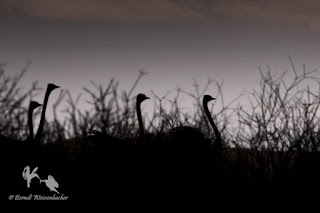

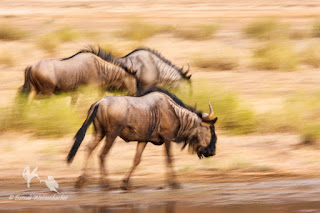

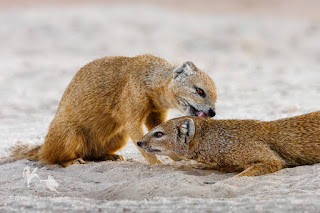
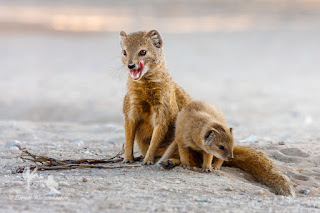

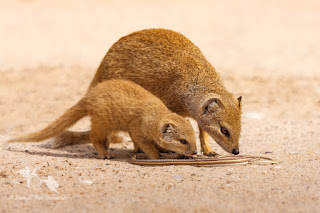
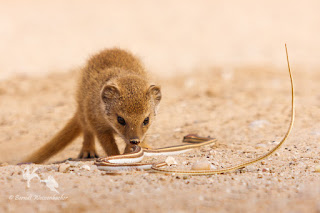
No comments:
Post a Comment